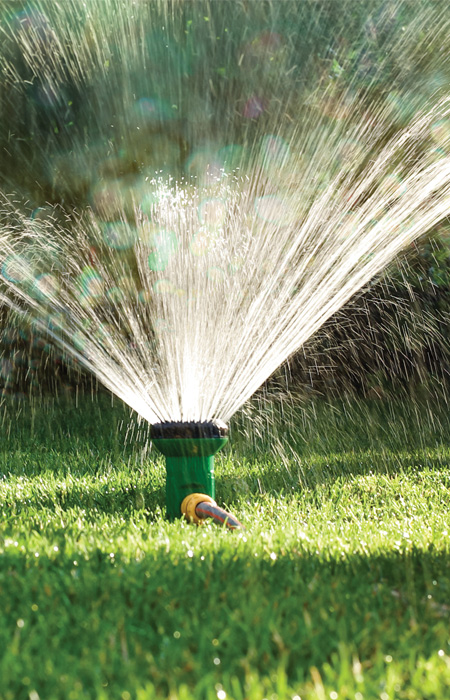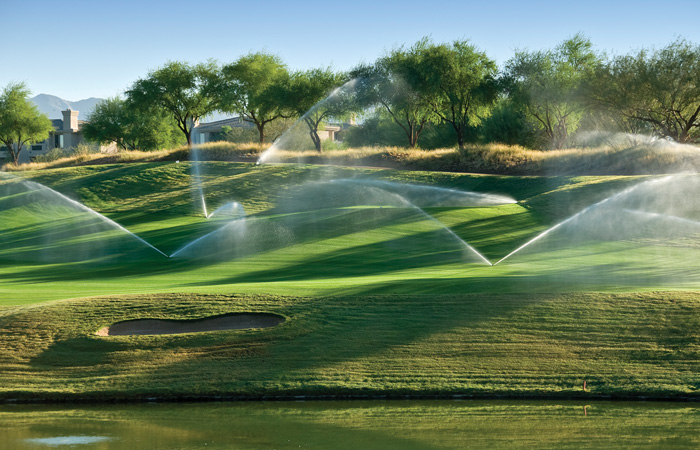We have arrived at the toughest, hottest part of the golf season and no matter what plantings and turf you have, you know that water management in July is critical for success, August is just around the corner, but smart watering now is paramount to protecting your green assets. This year has been quite a test for lawns and landscapes across Texas, with weather extremes that are rare even for the state. That leads to the most asked question to superintendents across the region this time of year: how can I maximize my water use in my home lawn/landscape? In short, how do I make sure I get the most out of every drop of water applied.
As usual, loyal readers, we will start with some basics on the topic, then answer the question with proven action steps. Let’s start with a statement about water use in general. It is never appropriate to overwater; it costs more money and creates a series of new problems, not to mention the environmental impact. Now let’s move into the art and science of maximizing water management for your lawn/landscape.
It is true all over the world that when we are getting adequate rainfall, no one thinks about maximizing the water use for their lawn or landscape, but when it stops raining and your green assets are in peril and drought restrictions are in place, you must transform into a skilled water manager in every sense of the word. Whether you have an in-ground automated irrigation system or you are still hand watering with a water hose with thumb or oscillating sprinkler, there are a few things you should know before opening the faucet and your wallet.
Weather Forecasts, Actuals and Watering Decisions
To water or not to water, that is the first question. We will deal with how much to water later (note the top 10 list). The weather forecast is never 100 percent accurate, but it must be included in your watering decisions. Get a good weather app for your phone (our favorites are AccuWeather, Radarscope and WeatherBug) or watch the local meteorologist each night on TV. Knowing there is a 90 percent chance of rain tomorrow should make you aware that you will likely not need to irrigate, or knowing that it’s a 10 percent chance of rain with 100-degree temperatures should make you increase your water accordingly. Now you see the water conundrum. You will learn to confirm whether it actually rained and how much it rained. Have you ever noticed a business or homeowner’s automated irrigation system watering during a heavy rain? Make sure you incorporate weather forecasts and actuals into your watering decisions and processes.

Action Steps: Get a weather forecast that you trust and install a rain gauge in your yard and use them. Note* the rain gauge should be installed 2-5 feet above the ground mounted on the side of a single post in an open area. The top of the rain gauge should extend several inches above the top of the mounting post. The mounting post should have a rounded, pointed or slanted top to avoid upward splash toward the rain gauge. Keep your own records to compare with online statistics to make the best water decisions possible. This alone will move you into the top 20 percent of water users.
General Watering Guidelines
Once you have decided to water, knowing what time of day to water for maximum effectiveness is the next question to be answered. Watering in the morning (before 10 a.m.) is the best time for your lawn and/or garden; it’s cooler and winds tend to be calmer in the morning so water can soak into the soil and be absorbed by the grass roots before it can evaporate. Remember, we want to maximize our water use considering the fate of every drop applied. It is also important not to overwater. Water until the soil is fully saturated (Field Capacity); avoid large puddles or runoff. Know your soils and plants. Some require very little water, while others need quite a bit of water to be healthy. So knowing that cacti use less water than live oaks and that Bermuda turf is more drought-tolerant than Fescue turf is important information for the avid irrigator.
Mulch Trees and Garden Beds: in addition to beautifying the landscape, mulch provides numerous services in the garden … from managing weeds to controlling soil erosion while also conserving water.
It would not be an AVIDGOLFER Ask the Superintendent article without a top 10 list, so here is our top 10 tips to make the most of your water resources in your home lawn/landscape or garden.
Top 10 ways to maximize water use in your home lawn, landscape and garden
No. 10: Know what type of soil you have and its general makeup, fertility, pH etc. Soil test information available at (http://soiltesting.tamu.edu), Note that soil types hold moisture differently; clay holds moisture better than sand.
No. 9: Know what plants/turf are present in your landscape and their basic water needs. For example, Fescue turf needs more water than Bermuda turf. Yucca uses less water than hollies.
No. 8: Watch and track weather and its impact on watering and evapotranspiration, which is the sum of evaporation from the land and water surfaces plus transpiration from plant root absorption. This will help you calculate how much water to apply to replenish water store in your soil and plants.
No. 7: Use the screwdriver test to see if your soil is properly hydrated. You should be able to easily push a 6” screwdriver into the ground of your lawn/garden; small moisture meters are available.
No. 6: Water deeply and infrequently to save water and encourage root depth; 2 or 3 deeper waterings per week are better than light watering every day. (See No. 1 for water recommendations)
No. 5: If you have an automated irrigation system, take a picture of the design blueprint or as-build (locations of sprinkler heads, valves, wire and controls location) with your cell phone so you can have easy access to this information. Do not wait to have a leak to find your water valves.
No. 4: Inspect all of your watering devices and system regularly to ensure proper coverage and working order. Consider a professional inspection or irrigation audit annually or monthly during the summer.
No. 3: Raise the HOC (Height of Cut) for lawns during periods of drought or high temperature to improve the plants’ ability to react to the stresses. Remember to never remove more than ⅓ of the leaf blade when mowing.
No. 2: If you have a brown area in turf or a wilted branch on an ornamental plant that is not responding to watering, be sure to check for other causes such as fungi (phytophthora), chinch bugs, army worms or even buried construction debris can mimic drought stress symptoms.
No. 1: Water appropriately. In general terms, your lawn needs 1” to 1.5” of water per week, even in the winter. If you get enough precipitation naturally, you’re all set. But if you do need to supplement or irrigate for extended periods, here is a simple way to water appropriately. Place several small containers (empty tuna cans work great) across the lawn or garden so that sprinkler water can fall naturally in them. Run your sprinkler until you get ½” in the cans. This usually takes about 20 minutes. So, by watering 20 minutes (enter your actual number) three times a week, you would be able to reach a weekly goal of 1.5” supplemental water. Adjust as needed for increased or decreased weekly totals or to adjust to our famous North Texas weather extremes.

Water is a precious resource and must be managed and measured to be sure we are making the most of every drop. Professional water managers use a variety of technologies to achieve their goals, and so can you. Maximizing the effectiveness of your home watering program for your lawn or landscape is basically a mix of science, art and commitment to monitoring and managed results.
To ensure that you are managing water resources appropriately, keep this article handy and practice the recommendations daily. It is also good to do your homework by attending local gardening and water-use classes or using a well-vetted internet search. By investing some time, you will save both money and water while achieving that sense of positivity that all avid gardeners aspire to.
I hope that you found these tips useful and will share them with your friends. We all benefit from water conservation and management. Be sure to thank your golf course superintendent for all he does for you and your club. He is one of the most educated water users in the industry and is always willing to share his knowledge. Just ask the superintendent.
Until next month avid golfers, play lots of golf … these are the longest daylight days of the year.